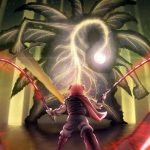Ranking the Elden Ring Bosses from Easiest to Hardest – Part 2
Every boss I could find in Elden Ring ranked for your amusement.
Elden Ring has been in our lives for just over a week now, and with it have come some incredible battles with some classic From Software difficulty foes.
Elden Ring Bosses
who is the hardest boss you’ll face? We’ve ranked all the Elden Ring bosses we’ve encountered so far from easiest to hardest, to give you some pointers AND see if you agree.
Sound off in the comments below if you agree or disagree with our take on Elden Ring’s bosses!
Hardest Elden Ring Boss Fights, Ranked
- Full-Grown Fallingstar Beast
- Dragonlord Placidusax
- Black Blade Kindred
- Fire Giant
- Margott, The Omen King
- Astel, Natural Born of the Void
- Godfrey, First Elden Lord/Horah Loux, Warrior
- Commander Niall
Bosses in Elden Ring are powerful enemies that adds challenging experiences to the game.
Bosses are encountered throughout the game in both the overworld and inside traditional dungeon-style levels. While some must be fought in order to progress through the story, many are optional. Each boss features a unique set of moves, gear, and various weaknesses and resistances to different damage types and styles of play.
What are the strongest bosses?
Successfully defeating a boss grants the player larger amounts of Runes than traditional enemies in their respective areas, and many offer rare and/or completely unique armaments, armor, magics, and other items. This page contains a list of all the bosses encountered in the game.
The 10 hardest bosses in Elden Ring ranked
Hardest Elden Ring Bosses Ranked: 10 Boss Battles That Will Make You Rage Quit
All the Dragons
As early as getting to the Dragon-Burnt Ruins just east of your starting location, you’ll see the Flying Dragon Agheel. Whoa, it’s a giant dragon that flies around and blankets the entire ground with fire! It seems cool at first, but then you realize everything it does just one-shots you.
Draconic Tree Sentinel
If you thought the Tree Sentinel from the beginning of the game was bad, wait until you get closer to the capital city of Leyndell. The Draconic Tree Sentinel is an upgraded version of the normal Sentinel, sporting a wide array of magic attacks.
Astel, Naturalborn of the Void
While carrying out the Ranni questline, Astel will be one of the last bosses you fight. This is a massive dragonfly-looking creature that resides in a massive arena. The aesthetics may be very pretty, but it has so many ranged and defensive attacks that you have to respect its space from mid-range. Get too close and you might get blown up by its pink magic or shockwaves. Get too far and you’ll get blasted by its laser attack.
Beast Clergyman/ Maliketh, the Black Blade
A story-related boss with two parts. First off, getting through the Crumbling Farum Azula is a pain because of all the tough enemies, including the Draconic Tree Sentinel at the front gate. Once you finally get to the Beast Clergyman, he does not let up for a second. He charges at you, throwing projectiles at you and creating lots of AoE attacks that make it hard to get in without taking damage. Once you get his health down to 50%, the fight transitions into Maliketh, the Black Blade.
Radagon of the Golden Order
This is the first form of the final boss in Elden Ring. Radagon may seem very straightforward with its short-ranged melee attacks and beam projectiles. While that’s true, this boss has a set of slam moves that are a bit tricky to avoid damage from.
Fallingstar Beast
For all the poor Tarnished who fell for the trap chest in the Dragon-Burnt Ruins, the Fallingstar Beast is a monstrosity that will put many to a quick, gravity-crushed grave. When you enter its arena, it’s almost right in your face.
Morgott – The Omen King
Morgott shares many similarities to a previous boss in Elden Ring – Margit, the Fell Omen, to whom Morgott bears a resemblance. But what makes Morgott different from Margit, however, is that he’s even more powerful.
Malekith – The Black Blade
Malekith is part of a two-part boss battle that takes place at the end of the Crumbling Farum Azula. The first part involves the Beast Clergymen, a giant creature with a penchant for firing projectiles and using a lot of area-of-effect attacks.
Once the player gets the beast’s health down to 50 percent, the fight with Malekith begins. Malekith is much more violent and agile than the Beast Clergymen – he moves around the stage belligerently, unleashing combos that can drain one’s stamina. Using the four pillars in the arena sometimes isn’t worth it, as Malekith can easily close in on the player.
How to defeat Malekith, the Black Blade in Elden Ring
Elden Ring has few mandatory bosses, compared to previous Soulsborne games.
After progressing in the story and igniting the kiln at the Forge of the Giants, you will be transported to Crumbling Farum Azula. You can leave the area as you progress, but you cannot advance the story without clearing the final boss of the area — Malekith, the Black Blade. He’s extremely difficult to fight, so here’s how to defeat Malekith, the Black Blade in Elden Ring.
There is a little bit of preparation you can do if you are confident in your parry abilities. First, head to the Beside the Great Bridge Site of Grace and head up. Instead of going straight towards the boss door, head down the flight of stairs and walk across the walkway. There are a few dragon enemies feigning death around here, so use target lock to find and eliminate them.
Malekith is actually a two-part fight, starting with the Beast Clergyman before transforming.
Beast Clergyman uses Beast incantations, such as Bestial Sling and Beast Claw. This first form isn’t terribly difficult — all of his attacks have normal wind-up and good tells, so with practice you can dodge everything he throws at you. When he reaches 60% life, a forced cutscene occurs and the much more difficult Malekith comes out.
Malekith will begin the fight with one of two attacks that is usually, but not always targeted at the Host of Fingers: a three to four hit melee combo or a four to six hit ranged combo. The melee combo is fairly simple to dodge — roll as his arm starts to come out with each swing, and always roll to the side to avoid the overhead smash. The ranged attack is a little more devious, as there is a very slight time delay due to the wave attacks traveling towards you. After the second or third wave attack, he will immediately close the gap for a massive melee swipe, which can one-shot you, so be on the lookout for that.
Mohg – Lord Of Blood
Mohg is an optional boss and defeating him is only optional for getting Elden Ring’s bad ending. He can cast out magical spells that can be easily dodged but can also deal big damage. It’s not until his health reaches below 50 percent that he kicks things into high gear, and cast out an unblockable blood spell across the screen.
Elden Ring Main Story Path: Stormveil Castle : Two bosses, the Grafted Scion and Lion Guardian, are optional, but its final boss, Godrick the Grafted, is not. Once defeated, Godrick the Grafted drops 15,000 runes, a Great Rune, and his Remembrance. Get the best of Den of Geek delivered right to your inbox!
Elden Ring bosses are all over the place. They’re tucked into caves, guarding castles, and deep, deep underground. It can be overwhelming when you’re starting out, there are so many bosses to choose from. But with some planning and a good strategy within the fight, you can chip away any boss in the game.
All Elden Ring Bosses do not respawn once defeated. Field Bosses are those found while exploring the overworld and are optional. They usually generate a “Enemy Felled” screen when slain. Greater Enemies are found blocking progress or guarding important, powerful items.
Also read :
- What are the best builds in Elden Ring and how to create these builds?
- Elden Ring crystal tear locations + Golden Seed locations: The Ultimate Guide
- 10 Most Disappointing Final Boss Fights, Ranked: Why are the Fights Disappointing?
- Elden Ring Bosses Guide, Complete List and How Do They Work
- The Best Multiplayer Games on PC in 2022 that you can choose
- The Best .io Games you can Play Right Now : Agar.io, Slither.io, Diep.io, Gats.io and more












